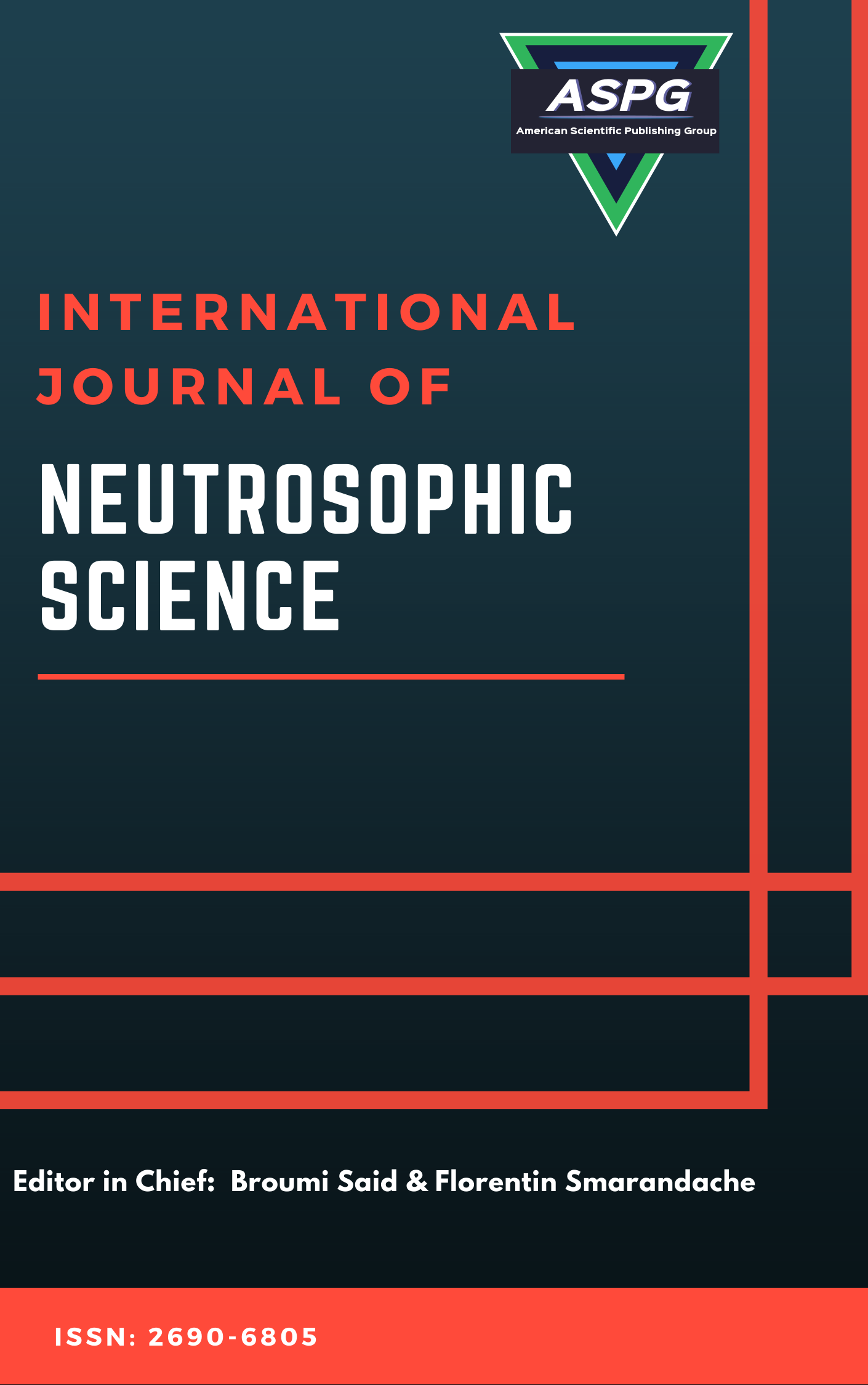

Volume 27 , Issue 2 , PP: 48-57, 2026 | Cite this article as | XML | Html | PDF | Full Length Article
Afrah Al Bossly 1 *
Doi: https://doi.org/10.54216/IJNS.270205
In this paper, we introduce a new extension of the transmuted Lindley distribution (TLD) by utilizing neutrosophic logic to handle uncertainties that are often found in real life data. As classical probability models are not flexible enough for dealing with vague, imprecise, ambiguous, and incomplete information, neutrosophic theory is more general as it handles indeterminacy part associated with data. The proposed neutrosophic transmuted Lindey distribution (NTLD) combines indeterminacy concept, yielding a powerful statistical distribution, which is suitable for modeling both randomness and indeterminacy. Major functions such as probability density function (PDF), cumulative function (CDF), reliability function (RF) and hazard rate function (HRF) are established in this framework. Graphical analysis and simulated data are used to illustrate the performance of the model. Moreover, important moments such as mean, variance, skewness, and kurtosis are computed for different values of the neutrosophic parameters. The proposed distribution provides a generalized approach to model complex and uncertain data in reliability engineering, survival analysis, and decision-making. A real electricity consumption data from energy sector is utilized to show the proposed model applicability.
Neutrosophic logic , Lindley model , Neutrosophic probability , Estimation
[1] K. M. Ramachandran and C. P. Tsokos, Mathematical Statistics with Applications in R. Academic Press, 2020.
[2] W. DeCoursey, Statistics and Probability for Engineering Applications. Elsevier, 2003.
[3] M. G. R. Faes, M. Daub, S. Marelli, E. Patelli, and M. Beer, "Engineering analysis with probability boxes: A review on computational methods," Structural Safety, vol. 93, p. 102092, 2021.
[4] J. Caban, A. Małek, and D. Kroczyński, "A method for assessing the technical condition of traction batteries using the metalog family of probability distributions," Energies, vol. 17, no. 13, p. 3096, 2024.
[5] H. M. Almongy, E. M. Almetwally, H. M. Aljohani, A. S. Alghamdi, and E. H. Hafez, "A new extended Rayleigh distribution with applications of COVID-19 data," Results in Physics, vol. 23, p. 104012, 2021.
[6] O. H. Odhah, H. M. Alshanbari, Z. Ahmad, F. Khan, and A. H. El-Bagoury, "A new family of distributions using a trigonometric function: Properties and applications in the healthcare sector," Heliyon, vol. 10, no. 9, 2024.
[7] D. Qayoom, A. A. Rather, N. Alsadat, E. Hussam, and A. M. Gemeay, "A new class of Lindley distribution: System reliability, simulation and applications," Heliyon, vol. 10, no. 19, 2024.
[8] M. E. Ghitany, B. Atieh, and S. Nadarajah, "Lindley distribution and its application," Mathematics and Computers in Simulation, vol. 78, no. 4, pp. 493–506, 2008.
[9] H. Zakerzadeh and A. Dolati, "Generalized Lindley distribution," Journal of Mathematical Extension, 2009.
[10] R. Shanker and A. Mishra, "A quasi Lindley distribution," African Journal of Mathematics and Computer Science Research, vol. 6, no. 4, pp. 64–71, 2013.
[11] K. V. P. Barco, J. Mazucheli, and V. Janeiro, "The inverse power Lindley distribution," Communications in Statistics - Simulation and Computation, vol. 46, no. 8, pp. 6308–6323, 2017.
[12] S. Nadarajah, H. S. Bakouch, and R. Tahmasbi, "A generalized Lindley distribution," Sankhya B, vol. 73, no. 2, pp. 331–359, 2011.
[13] F. Merovci, "Transmuted Lindley distribution," International Journal of Open Problems in Computer Mathematics, vol. 6, no. 2, pp. 63–72, 2013.
[14] Z. Karpíšek, P. Štěpánek, and P. Jurák, "Weibull fuzzy probability distribution for reliability of concrete structures," Engineering Mechanics, vol. 17, no. 5/6, pp. 363–372, 2010.
[15] J. J. Buckley, Fuzzy Probability and Statistics. Springer, 2006.
[16] L. A. Zadeh, "Fuzzy probabilities," Information Processing & Management, vol. 20, no. 3, pp. 363–372, 1984.
[17] E. L. En-lin and Z. You-ming, "Random variable with fuzzy probability," Applied Mathematics and Mechanics, vol. 24, no. 4, pp. 491–498, 2003.
[18] T. Denœux, "Uncertainty quantification in logistic regression using random fuzzy sets and belief functions," International Journal of Approximate Reasoning, vol. 168, p. 109159, 2024.
[19] F. Alduais and Z. Khan, "Development of neutrosophic gamma distribution for modeling neonatal mortality data," Neutrosophic Sets and Systems, vol. 79, no. 1, p. 48, 2025.
[20] F. Smarandache, "Introduction to Neutrosophy, Neutrosophic Set, Neutrosophic Probability, Neutrosophic Statistics and Their Applications to Decision Making," in Neutrosophic Paradigms: Advancements in Decision Making and Statistical Analysis: Neutrosophic Principles for Handling Uncertainty, pp. 3–21, 2025.
[21] R. Alhabib, M. M. Ranna, H. Farah, and A. A. Salama, "Some neutrosophic probability distributions," Infinite Study, 2018.
[22] A. B. Smith, J. D. Brown, and L. C. Green, "A novel approach to decision-making under uncertainty using fuzzy logic and neutrosophic theory," Journal of Applied Mathematics and Computation, vol. 15, no. 3, pp. 215–230, 2023.